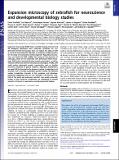| dc.contributor.author | Odstrcil, Iris | |
| dc.contributor.author | Förster, Dominique | |
| dc.contributor.author | Ramirez, Alyson | |
| dc.contributor.author | Gagnon, James A. | |
| dc.contributor.author | Randlett, Owen | |
| dc.contributor.author | Schoppik, David | |
| dc.contributor.author | Engert, Florian | |
| dc.contributor.author | Baier, Herwig | |
| dc.contributor.author | Freifeld, Limor | |
| dc.contributor.author | Costa, Emma K. | |
| dc.contributor.author | Asano, Shoh M | |
| dc.contributor.author | Celiker, Orhan Tunc | |
| dc.contributor.author | Gao, Ruixuan | |
| dc.contributor.author | Martin Alarcon, Daniel Alberto | |
| dc.contributor.author | Reginato, Paul Louis | |
| dc.contributor.author | Dick, Cortni D. | |
| dc.contributor.author | Chen, Linlin | |
| dc.contributor.author | Boyden, Edward | |
| dc.date.accessioned | 2018-07-24T17:16:56Z | |
| dc.date.available | 2018-07-24T17:16:56Z | |
| dc.date.issued | 2017-12 | |
| dc.date.submitted | 2017-04 | |
| dc.identifier.issn | 0027-8424 | |
| dc.identifier.issn | 1091-6490 | |
| dc.identifier.uri | http://hdl.handle.net/1721.1/117082 | |
| dc.description.abstract | Expansion microscopy (ExM) allows scalable imaging of preserved 3D biological specimens with nanoscale resolution on fast diffraction-limited microscopes. Here, we explore the utility of ExM in the larval and embryonic zebrafish, an important model organism for the study of neuroscience and development. Regarding neuroscience, we found that ExM enabled the tracing of fine processes of radial glia, which are not resolvable with diffraction-limited microscopy. ExM further resolved putative synaptic connections, as well as molecular differences between densely packed synapses. Finally, ExM could resolve subsynaptic protein organization, such as ring-like structures composed of glycine receptors. Regarding development, we used ExM to characterize the shapes of nuclear invaginations and channels, and to visualize cytoskeletal proteins nearby. We detected nuclear invagination channels at late prophase and telophase, potentially suggesting roles for such channels in cell division. Thus, ExM of the larval and embryonic zebrafish may enable systematic studies of how molecular components are configured in multiple contexts of interest to neuroscience and developmental biology. | en_US |
| dc.description.sponsorship | National Institutes of Health (U.S.) (Grant 1R01EB024261) | en_US |
| dc.description.sponsorship | National Institutes of Health (U.S.) (Grant 1R01MH110932) | en_US |
| dc.description.sponsorship | National Institutes of Health (U.S.) (Grant 2R01DA029639) | en_US |
| dc.description.sponsorship | National Institutes of Health (U.S.) (Grant 1R01NS087950) | en_US |
| dc.description.sponsorship | National Institutes of Health (U.S.) (Grant 1U01MH106011) | en_US |
| dc.publisher | National Academy of Sciences (U.S.) | en_US |
| dc.relation.isversionof | http://dx.doi.org/10.1073/PNAS.1706281114 | en_US |
| dc.rights | Article is made available in accordance with the publisher's policy and may be subject to US copyright law. Please refer to the publisher's site for terms of use. | en_US |
| dc.source | PNAS | en_US |
| dc.title | Expansion microscopy of zebrafish for neuroscience and developmental biology studies | en_US |
| dc.type | Article | en_US |
| dc.identifier.citation | Freifeld, Limor et al. “Expansion Microscopy of Zebrafish for Neuroscience and Developmental Biology Studies.” Proceedings of the National Academy of Sciences 114, 50 (November 2017): E10799–E10808 © 2017 the Author(s) | en_US |
| dc.contributor.department | Massachusetts Institute of Technology. Department of Biological Engineering | en_US |
| dc.contributor.department | Massachusetts Institute of Technology. Department of Brain and Cognitive Sciences | en_US |
| dc.contributor.department | Massachusetts Institute of Technology. Department of Electrical Engineering and Computer Science | en_US |
| dc.contributor.department | Massachusetts Institute of Technology. Media Laboratory | en_US |
| dc.contributor.department | McGovern Institute for Brain Research at MIT | en_US |
| dc.contributor.mitauthor | Freifeld, Limor | |
| dc.contributor.mitauthor | Costa, Emma K. | |
| dc.contributor.mitauthor | Asano, Shoh M | |
| dc.contributor.mitauthor | Celiker, Orhan Tunc | |
| dc.contributor.mitauthor | Gao, Ruixuan | |
| dc.contributor.mitauthor | Martin Alarcon, Daniel Alberto | |
| dc.contributor.mitauthor | Reginato, Paul Louis | |
| dc.contributor.mitauthor | Dick, Cortni D. | |
| dc.contributor.mitauthor | Chen, Linlin | |
| dc.contributor.mitauthor | Boyden, Edward | |
| dc.relation.journal | Proceedings of the National Academy of Sciences | en_US |
| dc.eprint.version | Final published version | en_US |
| dc.type.uri | http://purl.org/eprint/type/JournalArticle | en_US |
| eprint.status | http://purl.org/eprint/status/PeerReviewed | en_US |
| dc.date.updated | 2018-07-18T18:22:36Z | |
| dspace.orderedauthors | Freifeld, Limor; Odstrcil, Iris; Förster, Dominique; Ramirez, Alyson; Gagnon, James A.; Randlett, Owen; Costa, Emma K.; Asano, Shoh; Celiker, Orhan T.; Gao, Ruixuan; Martin-Alarcon, Daniel A.; Reginato, Paul; Dick, Cortni; Chen, Linlin; Schoppik, David; Engert, Florian; Baier, Herwig; Boyden, Edward S. | en_US |
| dspace.embargo.terms | N | en_US |
| dc.identifier.orcid | https://orcid.org/0000-0002-0739-6947 | |
| dc.identifier.orcid | https://orcid.org/0000-0002-5044-0296 | |
| dc.identifier.orcid | https://orcid.org/0000-0003-0547-8129 | |
| dc.identifier.orcid | https://orcid.org/0000-0002-7525-9047 | |
| dc.identifier.orcid | https://orcid.org/0000-0002-0419-3351 | |
| mit.license | PUBLISHER_POLICY | en_US |
